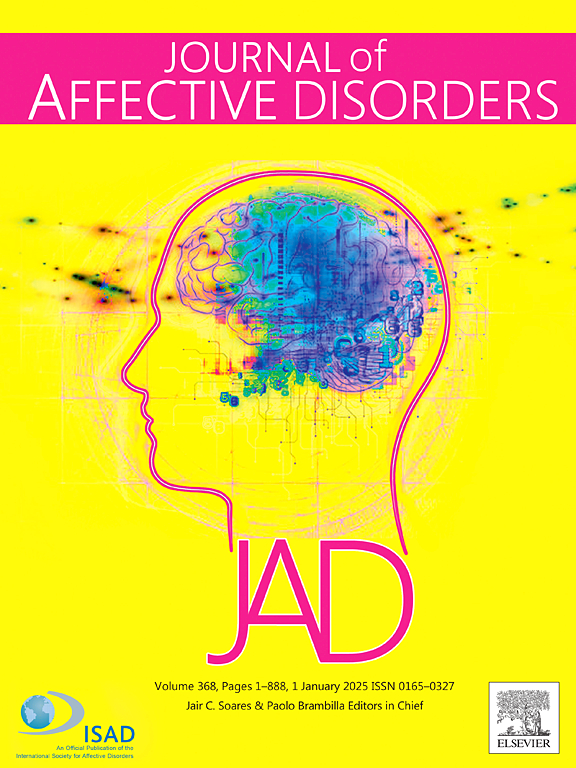Six-country psychometric comparison of women responses to the Depression Anxiety Stress Scale (DASS) and the Child and Adolescent Behaviour Inventory (CABI) across cultures and time
IF 4.9
2区 医学
Q1 CLINICAL NEUROLOGY
引用次数: 0
Abstract
Background
The Depression Anxiety Stress Scale (DASS) and the Child and Adolescent Behaviour Inventory (CABI) are freely accessible tools used to assess depression and externalizing symptoms, respectively. There is limited psychometric evidence on how these scales hold over time and across cultures. This study aims to evaluate the internal structure of both scales and their invariance across six countries and over two timepoints.
Methods
Data from the ParentChat Pilot Study included information from 566 adults (85.51 % female) with children aged 2 to 17. Only female data from North Macedonia, Malaysia, Moldova, Montenegro, Philippines, and South Africa were used. Confirmatory factor analysis was employed to assess invariance of each construct.
Results
At baseline, the DASS depression subscale achieved scalar invariance across five countries (CFI = 0.973, TLI = 0.956, RMSEA = 0.060, SRMR = 0.069) and across timepoints (CFI = 0.990, TLI = 0.979, RMSE = 0.037, SRMR = 0.034). The CABI extract achieved scalar invariance across two countries (CFI = 0.968, TLI = 0.963, RMSEA = 0.068, SRMR = 0.085) and across timepoints (CFI = 0.983, TLI = 0.980, RMSEA = 0.044, SRMR = 0.067).
Limitations
Small sample sizes, disproportionate female sample, and use of subscales or item extracts may limit generalizability. The scales were also not validated for all age groups used.
Conclusions
The study provides evidence of validity for the internal structure of the DASS and CABI extracts across cultures and over time. These findings support the use of these open-access tools in resource-limited settings to promote local research.
跨文化和时间的六个国家妇女对抑郁焦虑压力量表(DASS)和儿童与青少年行为量表(CABI)的反应的心理测量比较。
背景:抑郁焦虑压力量表(DASS)和儿童与青少年行为量表(CABI)是分别用于评估抑郁和外化症状的免费工具。关于这些量表如何随时间和文化变化而变化的心理测量证据有限。本研究旨在评估这两个量表的内部结构及其在六个国家和两个时间点上的不变性。方法:来自ParentChat试点研究的数据包括来自566名2至17岁儿童的成年人(85.51% %为女性)的信息。仅使用了来自北马其顿、马来西亚、摩尔多瓦、黑山、菲律宾和南非的女性数据。采用验证性因子分析评估各构念的不变性。结果:在基线,DASS抑郁内部氧化物实现标量不变性在五个国家(CFI = 0.973 TLI = 0.956,RMSEA = 0.060 SRMR = 0.069)和跨时间点(CFI = 0.990 TLI = 0.979,RMSE = 0.037 SRMR = 0.034)。CABI提取实现标量不变性在两个国家(CFI = 0.968 TLI = 0.963 RMSEA = 0.068 SRMR = 0.085)和跨时间点(CFI = 0.983 TLI = 0.980 RMSEA = 0.044 SRMR = 0.067)。局限性:小样本量,不成比例的女性样本,使用子量表或项目摘录可能会限制推广。这些量表也没有对所有使用的年龄组进行验证。结论:该研究为DASS和CABI提取物的内部结构在不同培养和时间的有效性提供了证据。这些发现支持在资源有限的环境中使用这些开放获取工具来促进当地研究。
本文章由计算机程序翻译,如有差异,请以英文原文为准。
求助全文
约1分钟内获得全文
求助全文
来源期刊

Journal of affective disorders
医学-精神病学
CiteScore
10.90
自引率
6.10%
发文量
1319
审稿时长
9.3 weeks
期刊介绍:
The Journal of Affective Disorders publishes papers concerned with affective disorders in the widest sense: depression, mania, mood spectrum, emotions and personality, anxiety and stress. It is interdisciplinary and aims to bring together different approaches for a diverse readership. Top quality papers will be accepted dealing with any aspect of affective disorders, including neuroimaging, cognitive neurosciences, genetics, molecular biology, experimental and clinical neurosciences, pharmacology, neuroimmunoendocrinology, intervention and treatment trials.
 求助内容:
求助内容: 应助结果提醒方式:
应助结果提醒方式:


